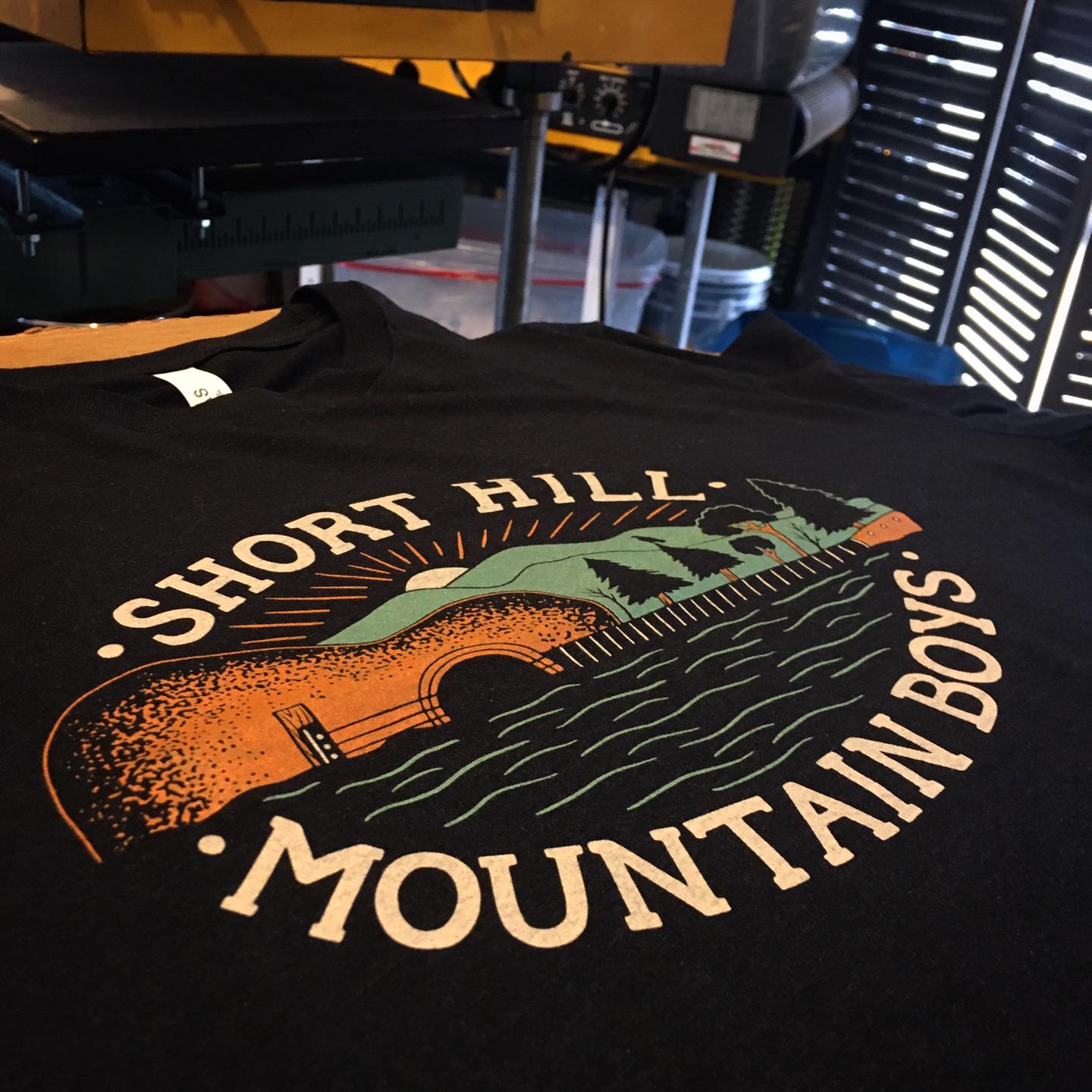Vintage Style Silk Screen Printing for Retro Fashion
Vintage Style Silk Screen Printing for Retro Fashion
Blog Article
Display Printing Uncovered: Everything You Required to Know Concerning Tee Shirt and Garment Printing Techniques
If you have actually ever wondered exactly how those dynamic layouts finish up on your preferred t-shirts, you remain in the ideal place. Display printing is a remarkable approach that integrates art with strategy, using endless opportunities for creative thinking. Recognizing the fundamentals, from equipment to ink selections, can significantly influence your results. Ready to explore the essential components that make display printing an art kind? Allow's discover the details that can elevate your tasks.
The Essentials of Screen Printing: Exactly How It Functions
When you plunge into screen printing, you'll discover it's both a scientific research and an art. At its core, display printing includes producing a pattern, or display, that allows ink to pass through just in details locations.
Setting the display over the material, after that make use of a squeegee to press ink via the screen onto the garment. Each action is important, and understanding them will certainly boost your display printing abilities, changing straightforward garments right into unique, expressive items.
Kinds of Screen Printing Strategies
Once you understand the essentials of screen printing, it's time to check out the various methods that can elevate your layouts. One popular method is conventional display printing, where ink is pressed via a stenciled display. This method is excellent for bold, vibrant colors. Then there's water-based ink printing, which offers a softer feel and is green, yet it calls for a different technique to curing.
An additional alternative is plastisol printing, recognized for its sturdiness and brilliant shades, making it a preferred for many brand names. Experiment with halftone printing to create slope effects and complex layouts.
Important Equipment for Display Printing
To attain magnificent lead to screen printing, having the appropriate tools is essential. Initially, you'll need a strong display printing framework, which holds the mesh that moves your layout onto the garment. Next off, buy high-grade squeegees; these are essential for using ink uniformly across the screen. You'll additionally need a great direct exposure system to produce your displays, along with a washout cubicle for cleaning them after use. A trusted warmth source, like a conveyor clothes dryer or warm press, is essential for healing your prints to guarantee durability. Don't neglect an appropriate work space, furnished with tables and storage for your supplies. Safety gear, such as masks and handwear covers, will certainly keep you secure from chemicals and inks. With the right tools, you'll be well on your method to creating professional-quality prints.
Choosing the Right Inks and Products
When choosing inks and products for screen printing, you require to take into consideration the sort of ink that works ideal for your project. Consider material compatibility to guarantee your designs look last and terrific lengthy. Also, discover eco-friendly ink choices to make your printing process much more lasting.
Sorts Of Screen Inks
Choosing the appropriate screen ink is essential for attaining lively, resilient prints that satisfy your task's needs. There are numerous kinds of display inks to take a look at. Specialty inks, such as glow-in-the-dark or metallic, can add unique impacts to your layouts.

Material Compatibility Factors To Consider
Understanding fabric compatibility is important for achieving high-quality screen prints, especially since different products respond distinctly to various inks. When selecting inks, consider the fabric type-- cotton, polyester, or blends. For cotton, water-based inks function well, offering gentleness and breathability. Polyester, on the other hand, commonly needs plastisol inks for far better bond and lively colors. You might need to utilize a mix of both types if you're publishing on blends. Constantly examine your inks on sample textile to ensure they adhere correctly and keep shade honesty. Additionally, keep in mind that textile weight and texture can affect the last end result, so selecting the appropriate ink and product combination is vital for your project's success.
Eco-Friendly Ink Options
Eco-friendly inks are coming to be a popular option for display printers who want to lessen their ecological influence while keeping top quality. When selecting inks, take into consideration water-based inks, which are less damaging and easier to clean up compared to typical solvents.
Furthermore, search for inks made from renewable resources, such as soy or vegetable-based alternatives. By selecting the best inks and materials, you'll not just create stunning designs but additionally add to a much more lasting printing process. Make the button, and your prints will certainly show your commitment to the atmosphere!
Preparing Your Layout for Screen Printing

Submit Layout Needs
To ensure your layout looks sharp and lively on textile, you'll require to pay attention to submit format demands for display printing. Start with vector documents like AI or EPS, as they can be scaled without losing top quality. If you use raster photos, select high-resolution documents, such as TIFF or PNG, ideally at 300 DPI. Prevent making use of JPEGs, as they can lose clearness when resized. Likewise, make sure your layout has a transparent background to avoid unwanted white edges on your prints. Finally, keep shade settings in mind; CMYK is standard for display printing, so convert your RGB develops as necessary. By following these guidelines, you'll set your artwork up for a successful print.
Shade Separation Methods
Color splitting up is an important step in preparing your style for display printing, and mastering it can substantially boost your print top quality. You'll need to break your design right into individual colors, as each shade requires a different display during printing. Start by determining all the shades in your style and create layers each. You can utilize software like Adobe check my site Photoshop or Illustrator to separate and different colors successfully. Be certain to save each layer as a separate file, typically in a format like TIFF or PSD. This precision not only guarantees exact shade representation yet additionally simplifies the printing process. By paying attention to color splitting up, you'll attain vivid and expert cause your screen-printed garments.
Resolution and Dimension
Attaining the very best lead to display printing starts with assuring your layout has the best resolution and size. Ideally, your artwork should go to the very least 300 DPI (dots per inch) for sharp, clear prints. If you use lower resolution, your end product could look pixelated and unprofessional.
When it concerns dimension, consider the dimensions of your print location. Layout your art work to match the last print size, ideally developing it in the real measurements you'll be printing. This way, you'll avoid any unexpected scaling problems.
Constantly check your design in both vector and raster styles. Vector graphics can be scaled without shedding high quality, making them ideal for screen printing. Preparing correctly will guarantee your style looks impressive on every garment!
Step-by-Step Screen Printing Refine
Screen printing is a dynamic process that enables you to produce vivid styles on various surface areas. To get going, you'll require a screen, emulsion, and your selected ink. First, prepare your screen by cleaning it completely. Next off, use the solution evenly and allow it completely dry in a dark location. As soon as completely dry, expose your screen to light with your style put on it, which will set the solution where the light hits, producing her explanation a pattern - screen printing kit.
After rinsing the unexposed solution, your screen prepares. Set it up on your printing surface area and align your garment beneath it. Put ink onto the display and make use of a squeegee to push the ink via the pattern onto the material. Lift the screen very carefully and let the print completely dry. Finally, heal the ink using heat to guarantee toughness. That's it! You've successfully display published your design.
Tips for Successful Screen Printing Projects
While you're diving right into your screen printing projects, bear in mind that preparation is vital to success. Begin by collecting all your materials-- inks, screens, garments, and mops. A clean work space helps stop unwanted errors, so clean up prior to you start.
Following, confirm your artwork is high-resolution and effectively sized for your garment. Check your display for proper direct exposure and clean it extensively to prevent smudges. When mixing your inks, comply with the maker's guidelines to achieve the best consistency.
Throughout printing, use even stress with your squeegee for constant results. Do not hurry; take your time to verify each print satisfies your requirements. After printing, let your garments completely dry completely prior to dealing with or packaging them.
Finally, constantly keep an example of your benefit future reference. By doing this, you can analyze your progression and improve your strategies over time. Pleased printing!

Frequently Asked Inquiries
How much time Does It Take to Establish a Display Printing Task?
Establishing a display printing task typically takes about half an hour to an hour. You'll prepare the screens, mix inks, and change journalism. The time differs based upon intricacy and experience, so stay arranged!
Can I Publish on Different Textile Keys In Utilizing the Very Same Method?
Yes, you can publish on different fabric types using the same technique, however you'll need to readjust your setups and inks. Some textiles absorb ink differently, so trying out warranties the very best results for every material.
What Are Usual Blunders to Prevent in Display Printing?
When display printing, avoid common mistakes like utilizing the incorrect ink, ignoring correct direct exposure times, or avoiding pre-press checks. Constantly test your configuration and keep tidy screens to assure quality outcomes each time.
Just How Can I Appropriately Tidy and Preserve My Display Printing Equipment?
To properly tidy and preserve your screen printing equipment, you ought to regularly clean screens with suitable solvents, inspect mops for wear, and assure all devices are kept dust-free and completely dry. Consistency protects against costly repairs and enhances efficiency.
Is Display Printing Eco-friendly Compared to Various Other Techniques?
Screen printing can be extra eco-friendly than other methods, particularly if you make use of eco-conscious products and water-based inks. By choosing lasting materials and methods, you minimize waste and reduce your effect on the earth.
Display Printing Uncovered: Everything You Need to Know Concerning Tee Shirt and Garment Printing Strategies
At its core, display printing involves creating a pattern, or screen, that permits ink to pass through only in specific locations. Setting the screen over the material, after that utilize a squeegee to press ink via the screen onto the garment. One preferred technique is standard screen printing, where ink is pressed via a stenciled screen.When picking inks and products for screen printing, you need to take into account the kind of ink that functions finest for your task.
Report this page